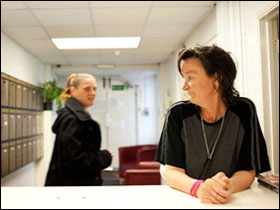About WFWN

THE ISSUE
There are plenty of formal statistics about the number of homeless people in the UK: local government numbers on individuals and families placed in temporary accommodation; homeless charities’ overnight counts of rough sleepers; official lists of residents at shelters, hostels and supported flats. But the real number is likely to be much larger than official figures show. Behind the front line of the visible homeless are countless others with only the most tenuous grasp on accommodation, obscured from view and concealed from official measurement.
These are the hidden homeless. They move between friends’ sofas and floors. They camp out in fragile squats and unsafe housing. A significant number are women, pushed further into the shadows of an already shadowy existence by the fear of losing children, the stigma of apparent domestic failure or the dangers of sleeping rough.
Homeless women will often resort to extreme measures to keep a roof over their heads: remaining in abusive relationships, engaging in sex work or committing minor crimes to be taken into custody. Others are found in crack houses and brothels, where they are controlled by pimps and drugs. For women that do end up on the streets, hidden sleeping sites away from the more obvious doorways and subways may protect them from immediate dangers, but can isolate them from potential help.
When they do access help, they find that much of it is designed for homeless men. But women respond very differently to both the threat and the reality of homelessness. Dig deep into the background of most homeless women and histories of domestic abuse, neglectful or abusive childhoods, and loss of their own children will often emerge. The cumulative effect of these profound and deeply personal traumas is that women are more reluctant to seek out help; when they do, they have higher and more complex needs than are typically seen in men and take much longer to successfully recover and rebuild their lives. Supporting homeless women therefore requires a very different approach, based on a greater understanding of their specific needs.
Where from? Where now? is an in-depth multimedia project that tells the individual stories of a small number of homeless women in London, looking at the reasons that have led to their homelessness and how they are rebuilding their lives.
THE PROJECT
The Where from? Where now? project aims to create a textured picture of the day-to-day reality of homelessness as experienced by the women who are living through it and the insights from the people who support them. Over a period of eight months, I spent time in hostels, joined outreach teams, met rough sleepers, as well as the ‘hidden homeless’, and spoke to women who had moved on to the next stages of supported housing and those who had found a home.
The resulting photofilm, written stories and audio clips, told in the women’s own words, combine with photography to highlight the difficult and complex issues faced by these women, whilst helping to challenge perceptions of women’s homelessness.
This Where from? Where now? website is an online platform that brings together the work created over the 18 month long project, which culminated in an exhibition at gallery@oxo on London’s South Bank in November 2012.
The project blog provides extra commentary from the women and support staff, as well as my own thoughts and impressions written over the duration of the project. Additional research concerning topics of specific relevance to women’s homelessness, eg motherhood and prostitution, including interviews with support staff can also be found on the homepage.
ST MUNGO’s
Where from? Where now? supports St Mungo’s women’s strategy which has been running since 2011.
St Mungo’s is a leading provider of services for homeless people in London and the south of England. The strategy aims to improve the support and services available to women, so that they are able to rebuild their lives and achieve their potential. It recognises that, in addition to providing help with housing, health and employment, women’s emotional and psychological needs must be addressed and their ability to manage safe and secure personal relationships developed. St Mungo’s supports homeless women through a range of specialist services, including women-only hostels, semi-independent housing projects and women’s groups.
In June 2012, St Mungo’s launched a campaign, Rebuilding Shattered Lives, which aims to raise awareness of women’s homelessness, share good practice and drive lasting change.
Thanks
First and Foremost to all the women who have allowed me into their lives. I am extremely grateful for your generosity.
Where from? Where now? is supported by Thomson Reuters Elite to whom I am really thankful for making this project possible.
Thank you also to The KnowList who have provided web resources for the project.
Thank you too to ALL the people at St Mungo’s who have helped me in the build up to the project and for the access they have given me on the ground.
Also, a big thank you to Dan Stevens and WJB Creative for all their help in setting up this website.
And to the fantastic freelance writer Sarah Carrington, for all her work editing and writing for the exhibition and this website. And the talented (and ever-patient) picture editor Shannon for all the hours and expertise she has given to this project throughout the exhibition production and beyond.
Please note: Some of the women’s names, locations and personal details have been changed at their request.